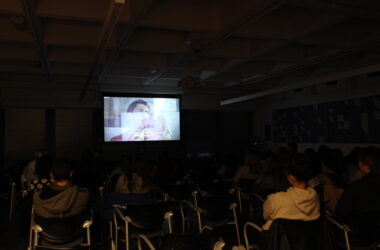The Killing of a Sacred Deer opens with Schubert’s grandiose “Stabat Mater” playing over an extreme close-up of a human heart mid-operation, followed by a conversation between two surgeons about wristwatch straps. Within minutes, director Yorgos Lanthimos sets the tone for the film: Darkly eccentric, fearlessly macabre, and meticulously choreographed. However, underneath its spectacle, and despite some incredible performances, The Killing of a Sacred Deer falls short of the depth and emotional resonance it seems to want to achieve.
The title of The Killing of a Sacred Deer references the myth of King Agamemnon, who killed one of Artemis’ deer and had to sacrifice his own daughter to appease the goddess. In his fifth feature, Lanthimos explores crime and punishment, the fragility of family bonds, and the consequences of playing god.
Colin Farrell, in his second time working with Lanthimos following 2015’s The Lobster, plays a successful cardiologist, husband to a wife of 16 years (Nicole Kidman), and father of two children (Raffey Cassidy and Sunny Suljic). His seemingly-idyllic life is torn to shreds with the arrival of oddball teenager Martin (Barry Keoghan), and he is forced to make a choice with life-or-death consequences.
Farrell and Kidman are in top-form, presenting Lanthimos’ trademark stilted dialogue with remarkable nuance, communicating layers of subtext through the subtlest body language. However, the star of the show is undoubtedly Barry Keoghan ('71 (2014), Trespass Against Us (2016)), fresh off of his mainstream debut in Dunkirk, who steals every scene with just the right blend of charming awkwardness and spine-chilling menace.
Lanthimos has clearly drawn inspiration from Michael Haneke (Amour, (2012); Funny Games, (1997)) in his unflinching stare into the depths of cruelty and horror, all painted with a glaze of deadpan masochism and pitch-black comedy. Jarring musical cues punctuate the film’s surreal slow burn; slaps and gunshots resonate like thunderclaps through the soundscape. Stanley Kubrick’s posthumous fingerprints are all over the cinematography: Dreamlike tracking shots follow characters down hallways and windy roads, or frame them dwarfed by cavernous rooms. The world of the film is cold and antiseptic, as painstakingly curated as a museum. Every beat of action, every move of the camera, every edit, is graceful and deliberate; Lanthimos never puts a foot wrong.
Sadly, other than its technical prowess, nothing that The Killing of a Sacred Deer presents is truly remarkable. While Lanthimos brands every moment with his auteur stamp, the gravitas with which he approaches his themes suggests that he believes he is treading new ground. However, filmgoers have seen too many films to count about dangers in suburbia, emotional distance in modern society, repressed sexuality, the sins of the father. Everything The Killing of a Sacred Deer says has already been said by other directors, from Haneke to Lynch to Polanski—repeatedly, and better. Lanthimos is offering little new, apart from technical and visual flair.
The Killing of a Sacred Deer is stunning and brutal, a masterclass in arthouse filmmaking, but its cold-heartedness and maddening, bizarre horror make it truly difficult to sit through for even the most resilient of viewers. The emotional distance between the characters (and between the audience and the characters), while clearly intentional, still leaves viewers floundering in an emotional void, with little to invest them in the plights of the characters or offer any catharsis at all. Just as Kidman seduces her husband by lying motionless on the bed—“general anaesthetic,” as she calls it—so too does Lanthimos try to seduce his audience with the allure of watching a truly alarming tale through an apathetic lens. When The Killing of a Sacred Deer reaches its fierce final act, there is little to do but watch the horrific action play out with the same cool indifference as its characters, a frustrating and hollow payoff after being trapped in a two-hour nightmare.









After I read your article I was very interested and it was very helpful for me , I wait for your next other article ,thanks. Bandar Togel